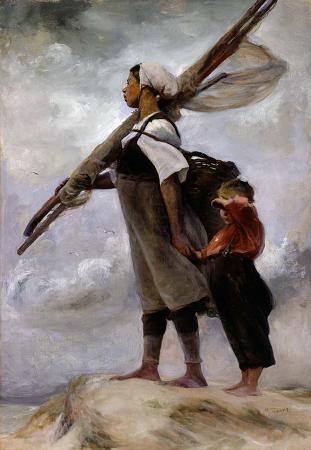Elizabeth Nourse (1859 - 1938). Elizabeth Nourse was a realist-style genre, portrait, and landscape painter born in Mt. Healthy, Ohio, in the Cincinnati area. She also worked in decorative painting and sculpture. Described by her contemporaries as the first woman painter of America and the dean of American woman painters in France and one of the most eminent contemporary artists of her sex, Nourse was the first American woman to be voted into the Société Nationale des Beaux-Arts. She also had the honor of having one of her paintings purchased by the French government and included in the Luxembourg Museum's permanent collection. Nourse's style was described by Los Angeles critic Henry J. Seldis as a forerunner of social realist painting.Some of Nourse's works are displayed at the Cincinnati Art Museum. Born to the Catholic household of Caleb Elijah Nourse and Elizabeth LeBreton Rogers Nourse on October 26, 1859, Elizabeth and her twin sister, Adelaide, were the youngest of 10 children. She attended the McMicken School of Design in Cincinnati at age 15, and was one of the first women admitted to the women's life class offered there taught by Thomas Satterwhite Noble. She also studied watercolor painting while there. She studied at the school for seven years and was even offered a teaching position, which she declined in order to focus on her painting. In 1882, both of her parents died, and with the assistance of an art patron, she went to New York City to continue her studies, briefly in the Art Students League. Here, she met William Merritt Chase and visited him in his studio. In 1883, she had returned to Cincinnati and made her living decorating home interiors and painting portraits. From 1884-1886, she spent most of her summers in Tennessee in the Appalachian Mountains doing watercolor landscapes. In 1887, she moved to Paris, France along with her older sister, Louise, who was to be her lifelong companion, business manager, housekeeper and hostess. In Paris, she attended Académie Julian, studying under Gustave Boulanger and Jules Lefebvre. While studying in Paris Nourse became acquainted with fellow painter Caroline Augusta Lord. Already having advanced skill when she arrived and having developed her style while in Cincinnati, she quickly finished with her studies and opened her own studio. In 1888, her work was featured in her first major exhibition at the Société des Artistes Français. Her subjects were often women, mostly peasants, and depictions of France's rural countryside. Though continuing to live and work mainly in Paris, Nourse travelled extensively around Europe, Russia, and North Africa painting the people she met. She was one of the New Women of the 19th century successful, highly trained women artists who never married, like Ellen Day Hale, Mary Cassatt, Elizabeth Coffin and Cecilia Beaux. Hale, Nourse, and Coffin created compelling self-portraits in which they fearlessly presented themselves as individuals willing to flout social codes and challenge accepted ideas regarding women's place in society. Indeed, the New Women portraits of the 1880s and 1890s are unforgettable interpretations of energetic, self-confident and accomplished women. During the first world war, Nourse defied the tendency of most American emigres to return home and remained in Paris, where she worked to assist the war's refugees and solicited donations from her friends in the United States and Canada for the benefit of people whose lives were disrupted by the war. In 1921, she was awarded the Laetare Medal for distinguished service to humanity by a Catholic layperson, an annual award from Notre Dame University in Indiana. Nourse retired and when her sister died in 1927, she became ill and depressed. In 1920, she was operated on for breast cancer, and, in 1937, the cancer returned. She died on October 8, 1938.
more...









